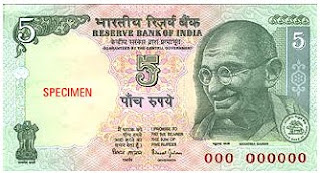"The Indian currency is called the Indian Rupee (INR) and the coins are called paise. One Rupee consists of 100 paise. The Reserve Bank manages currency in India. The Government, on the advice of the Reserve Bank, decides on the various denominations. The Reserve Bank also co-ordinates with the Government in the designing of bank notes, including the security features."
Bank Notes:
The Reserve Bank of India has the sole authority to issue banknotes in India. Reserve Bank, like other central banks the world over, changes the design of banknotes from time to time.
The Reserve Bank has introduced banknotes in the Mahatma Gandhi Series since 1996 and has so far issued notes in the denominations of Rs.5, Rs.10, Rs.20, Rs.50, Rs.100, Rs.500 and Rs.1000 in this series.
Each banknote has its amount written in 17 languages (English & Hindi on the front, and 15 others on the back) illustrating the diversity of the country.
Contemporary Currency notes have 15 languages on the panel which appear on the reverse of the note.
"The Obverse Side of all Bank Notes got Mahatma Gandhi Picture."
One Thousand Rupee:
Size - 177mm X 73mm
Date of Issue - October 2000
Main Color - Amber-Red
Five Hundred Rupee:
Size - 167mm X 73mm
Year of Issue - 1997
Main Color - Olive and yellow
The picture in the reverse side of the note describes the DANDI MARCH
One Hundred Rupee:
Size - 157mm X 73mm
Year of Issue - 1996
Main Color - Blue-green at centre, brown-purple at 2 sides
The picture in the reverse side is 'The Himalayan Mountains'
Fifty Rupee:
Size - 147mm X 73mm
Year of Issue - 1997
Main Color - Violet
The backside Picture depicts the Parliament of India
Twenty Rupee:
Size -147mm X 63mm
Year of Issue - 2002
Main Color - Red-orange
The reverse side picture is Palm Trees
Ten Rupee:
Size - 137mm X 63mm
Year of Issue - 1996
Main Color - Orange-violet
The reverse side picture contains Rhinoceros, elephant, tiger
Five Rupee:
Size -117mm X 63mm
Year of Issue - 2002
Main Color - Green
The reverse side picture is Tractor
Coins:
"Coins were issued in independent India in 1950"















No comments:
Post a Comment